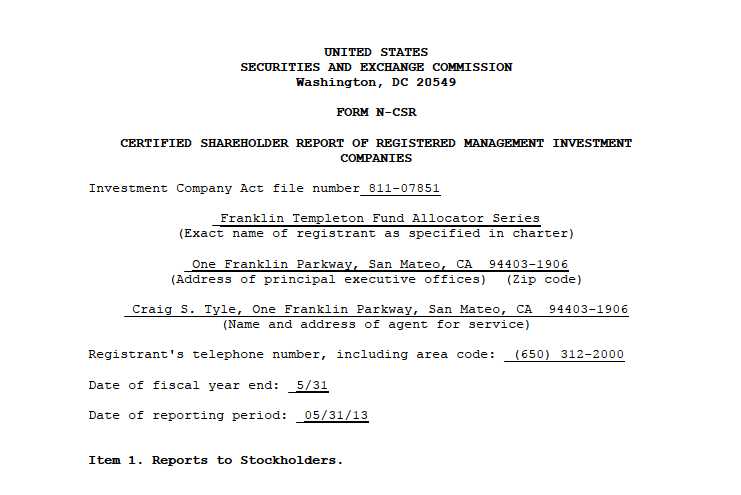
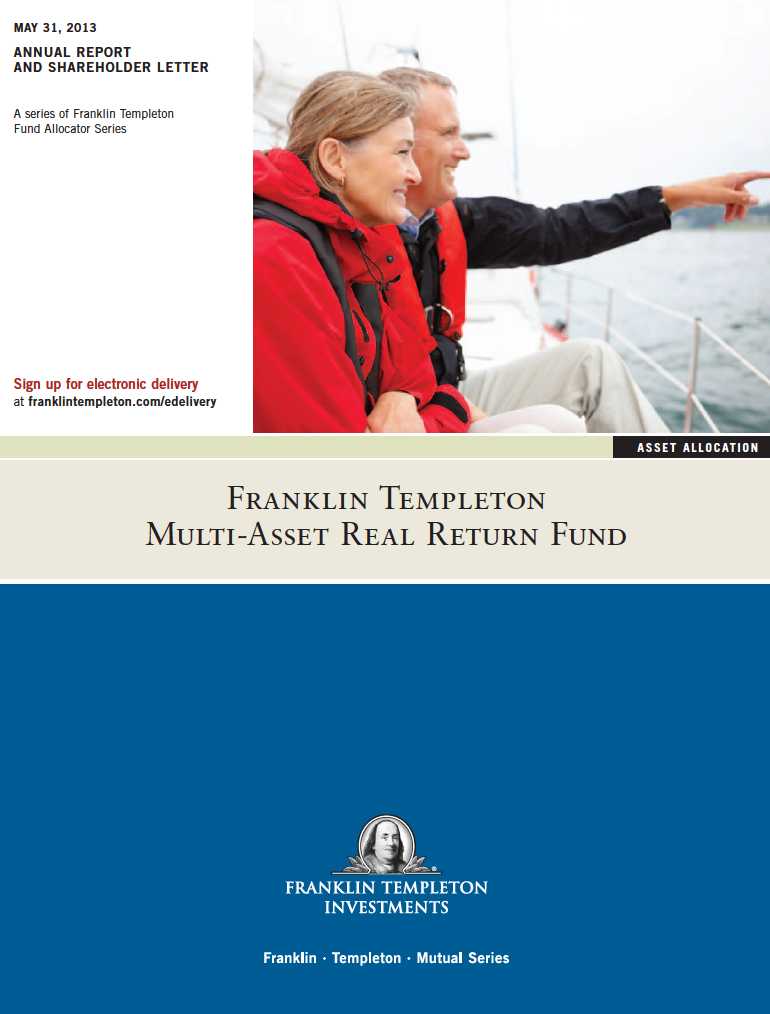

| 1
Annual Report
Franklin Templeton Multi-Asset Real Return Fund
Your Fund’s Goal and Main Investments: Franklin Templeton Multi-Asset Real Return Fund seeks real return, which is total return that exceeds U.S. inflation over a full inflation cycle, typically five years. The Fund is structured as a limited “fund-of-funds,” meaning that it seeks to achieve its investment goal by investing its assets primarily in other mutual funds, predominantly other Franklin Templeton mutual funds (underlying funds). The Fund also invests a portion of its assets in inflation-indexed securities, predominantly Treasury Inflation-Protected Securities (TIPS).
Performance data represent past performance, which does not guarantee future results. Investment return and principal value will fluctuate, and you may have a gain or loss when you sell your shares. Current performance may differ from figures shown. Please visit franklintempleton.com or call (800) 342-5236 for most recent month-end performance.
We are pleased to bring you Franklin Templeton Multi-Asset Real Return Fund’s annual report for the fiscal year ended May 31, 2013.
Performance Overview
Franklin Templeton Multi-Asset Real Return Fund – Class A posted a +7.03% cumulative total return for the 12 months under review. In comparison, the Fund’s primary benchmark, the Barclays U.S. 1-10 Year TIPS Index, which tracks performance of inflation-protected notes issued by the U.S. Treasury that have at least one year and less than 10 years to final maturity, had a -0.77% total return.1 The Fund’s secondary benchmark, the Consumer Price Index (CPI) for Urban Consumers (All Items) NSA (non-seasonally adjusted), a measure of the average change in prices of all goods and services purchased for consumption by urban householders, rose 1.36% for the same period.2 The Fund’s equity benchmark, the Standard & Poor’s® 500 Index (S&P 500®), a broad measure of U.S. stock performance, posted a +27.28% total return, and its fixed income benchmark, the Barclays U.S. Aggregate Index, which tracks U.S. investment-grade bonds, posted a +0.91% total return.1 You can find other performance data in the Performance Summary beginning on page 8.
1. Source: © 2013 Morningstar. All Rights Reserved. The information contained herein: (1) is proprietary to Morningstar and/or its content providers; (2) may not be copied or distributed; and (3) is not warranted to be accurate, complete or timely. Neither Morningstar nor its content providers are responsible for any damages or losses arising from any use of this information. STANDARD & POOR’S®, S&P® and S&P 500® are registered trademarks of Standard & Poor’s Financial Services LLC. The indexes are unmanaged and include reinvestment of any income or distributions. One cannot invest directly in an index, and an index is not representative of the Fund’s portfolio.
2. Source: Bureau of Labor Statistics.
The dollar value, number of shares or principal amount, and names of all portfolio holdings are listed in the Fund’s SOI, which begins on page 19.
Annual Report | 3
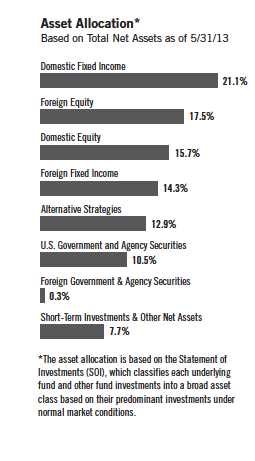
Economic and Market Overview
The global economic recovery was mixed during the period under review. Economic growth slowed in several regions, including the eurozone, which posted its sixth consecutive quarter of gross domestic product (GDP) contraction in the first quarter of 2013. China reported its first acceleration in GDP growth in two years for the fourth quarter of 2012, easing fears of a “hard landing” and making a steady and sustainable Chinese growth scenario for 2013 seem more likely. Japan’s introduction of an inflation target, a likely monetary policy shift, and talks of increased easing with more and wider asset purchases contributed to optimism that the country’s long fight against deflation could eventually be won and supported a rally in Japanese stocks.
In Europe, Italy’s inconclusive election results and failed attempts at forming a new coalition government, as well as concerns about Cyprus’s banking sector, re-energized the European sovereign debt crisis during the first quarter of 2013. These headwinds pressured European markets while economic conditions in the eurozone remained downbeat. Outside the eurozone, the U.K. economy slowed in 2012’s fourth quarter after posting strong third-quarter growth, which, together with stressed public finances, contributed to the loss of the country’s AAA credit rating in February 2013.
Intensifying fiscal uncertainty and budget debates in the U.S. led domestic stock markets, as measured by the S&P 500, to underperform most other global equity markets in 2012’s fourth quarter. However, the Federal Reserve Board’s (Fed’s) affirmation for continued monetary stimulus, a third year of corporate profit growth and supportive economic data in 2013’s second quarter provided reassurance that contributed to new highs for two major U.S. equity indexes. Many key elements of the U.S. economy continued their uptrend, including strong retail sales that reflected consumption that was seemingly undamaged by increased payroll taxes, and a housing rebound supported by large increases in home prices and purchases. Several measures of employment also improved during the period; the jobless rate fell to a post-recession low and multiple measures of consumer sentiment approached or reached five-year highs.
Global developed and emerging market stocks, as measured by the MSCI All Country World Index, delivered solid gains during the 12 months under review as redoubled policy support and continued corporate earnings strength helped buoy global equity markets. Developed market stocks, as measured by the MSCI World Index, outperformed their emerging market counterparts, as measured by the MSCI Emerging Markets Index, for the 12-month period. Frontier markets, as measured by the MSCI Frontier Markets Index, outperformed both developed and emerging markets.
4 | Annual Report
Although global stocks generally made strong gains, other asset classes posted more modest performance. Global bonds, as measured by the Barclays Global Aggregate Index, declined slightly. However, fueled by demand from yield-seeking investors, high yield and emerging market bonds delivered double-digit returns. Commodity prices were mixed during the period. Crude oil, natural gas, platinum and palladium gained, while gold, silver, aluminum, copper and steel declined. By period-end, the yield on the 10-year U.S. Treasury had increased to 2.16% from 1.59% a year earlier.
Investment Strategy
Under normal market conditions, we allocate the Fund’s assets among the broad asset classes representing exposure to global equities, global fixed income and commodities markets by investing primarily in a combination of underlying funds, based on each underlying fund’s predominant asset class. These underlying funds, in turn, invest in a variety of U.S. and foreign equity, fixed income and money market securities, and commodity-linked instruments. We will vary the underlying funds’ allocation percentages based on the current inflationary and economic environment and our tactical views. When selecting equity funds, we consider the underlying funds’ foreign and domestic exposure, market capitalization ranges and investment style (growth vs. value). When selecting fixed income funds, we focus primarily on maximizing income. We invest in commodities funds, TIPS and other inflation-indexed securities, floating rate notes and inflation-sensitive equity funds in an effort to improve the portfolio’s inflation hedging properties.
With respect to the portion of the Fund’s portfolio invested in inflation-indexed securities, the investment manager has engaged Franklin Templeton Institutional, LLC, to manage the Fund’s assets invested in inflation-indexed securities, predominantly TIPS. Such securities are structured to provide protection against inflation. In periods shorter than a full inflation cycle, the Fund’s returns may be volatile compared with the CPI or lag behind inflation.
Manager’s Discussion
During the 12 months under review, near-term inflation risks remained subdued, with import prices, employment costs, producer prices and other indicators pointing toward tame inflation. We continued to monitor the threat of inflation driven by commodity prices and monetary policy, with the latter being a potentially longer term threat, in our opinion. The inflation data led us to construct a portfolio that favored global fixed income and core equity at period-end. During the period, as we became more comfortable with the potential for sustainable economic growth in the U.S. and emerging market countries, we
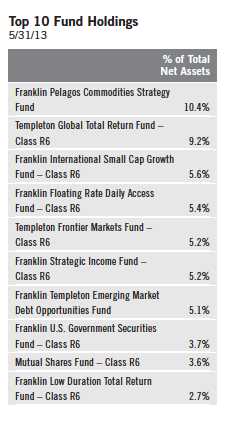
Annual Report | 5
increased our beta exposure.3 Increasing exposure to assets that have historically performed better in bull market environments may benefit the Fund if markets continue to rise. As a result, we added to our exposure in foreign equities, floating rate corporate bonds and emerging market debt. We continued to be watchful of the potential global impact of the economic developments in Europe and the U.S. Federal Reserve Board’s timeline for ending its bond purchasing program, which kept us somewhat cautious during the period.
From an asset class perspective, foreign equity, domestic equity, domestic fixed income and foreign fixed income securities generally supported absolute Fund performance. Within foreign equity, Franklin International Small Cap Growth Fund – Class R6, Templeton Foreign Fund – Class R6 and Templeton Frontier Markets Fund – Class R6 were top performers. Within domestic equity, Franklin MicroCap Value Fund – Class R6, Mutual Shares Fund – Class R6 and Franklin Growth Opportunities Fund – Class R6 performed particularly well. Within domestic fixed income, Franklin High Income Fund – Class R6 and Franklin Strategic Income Fund – Class R6 were notable performers. The Fund’s foreign fixed income holdings, Templeton Global Total Return Fund –Class R6 and Franklin Templeton Emerging Markets Debt Opportunities Fund, boosted returns. The Fund’s commodity holding, Franklin Pelagos Commodities Strategy Fund, also benefited Fund performance. In contrast, Franklin Pelagos Managed Futures Strategy Fund, Franklin U.S. Government Securities Fund –Class R6 and Franklin Gold and Precious Metals Fund – Class R6 detracted from the Fund’s performance. The Fund’s holdings in inflation-indexed securities also hurt performance.
The Fund ended the period with 33.2% of total net assets in equity (15.7% domestic funds and 17.5% foreign funds), 45.9% in fixed income (21.1% domestic funds, 14.3% foreign funds and 10.8% inflation-indexed securities), 12.9% in alternative strategies (commodity and managed futures), and 7.7% in short-term investments (cash) and other net assets. With respect to inflation positioning, the Fund’s portfolio ended the period with 26.6% of total net assets in core equity funds (having a relatively high correlation to the S&P 500), 30.0% in core fixed income funds (having a relatively high correlation to the Barclays U.S. Aggregate Index), 33.2% in inflation-sensitive strategies, 2.5% in managed futures, and 0.6% in cash and other net assets. Inflation-sensitive strategies consisted of 10.4% of total net assets in commodities, 6.6% in inflation-sensitive equity funds and 16.2% in inflation-sensitive fixed income securities, specifically 10.8% in inflation-indexed securities and 5.4% in floating rate loans.
3. Beta is a measure of portfolio volatility compared to a benchmark.
6 | Annual Report
Thank you for your participation in Franklin Templeton Multi-Asset Real Return Fund. We look forward to serving your future investment needs.
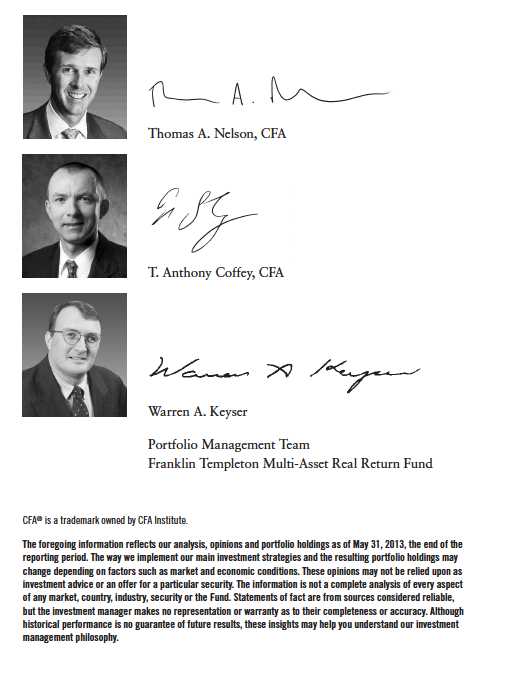
Annual Report | 7
Performance Summary as of 5/31/13
Your dividend income will vary depending on dividends or interest paid by securities in the Fund’s portfolio, adjusted for operating expenses of each class. Capital gain distributions are net profits realized from the sale of portfolio securities. The performance table and graphs do not reflect any taxes that a shareholder would pay on Fund dividends, capital gain distributions, if any, or any realized gains on the sale of Fund shares. Total return reflects reinvestment of the Fund’s dividends and capital gain distributions, if any, and any unrealized gains or losses.
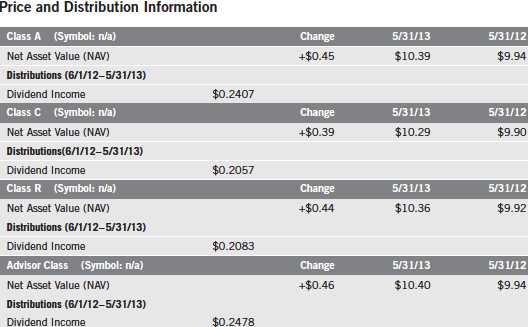
8 | Annual Report
Performance Summary (continued)
Performance1
Cumulative total return excludes sales charges. Average annual total returns and value of $10,000 investment include maximum sales charges. Class A: 5.75% maximum initial sales charge; Class C: 1% contingent deferred sales charge in first year only; Class R/Advisor Class: no sales charges.
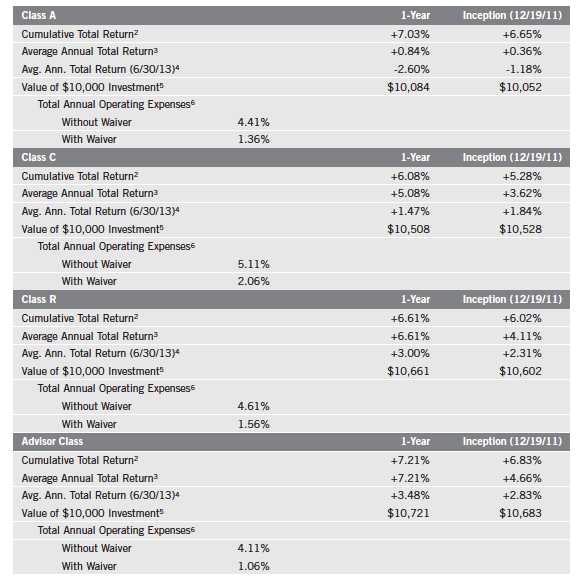
Performance data represent past performance, which does not guarantee future results. Investment return and principal value will fluctuate, and you may have a gain or loss when you sell your shares. Current performance may differ from figures shown. For most recent month-end performance, go to franklintempleton.com or call (800) 342-5236.
The investment manager has contractually agreed to waive fees or assume certain expenses so that common expenses (excluding Rule 12b-1 fees and acquired fund fees and expenses) for each class of the Fund do not exceed 0.45% (other than certain nonroutine expenses) until 9/30/13.
Annual Report | 9
Performance Summary (continued)
Total Return Index Comparison for a Hypothetical $10,000 Investment
Total return represents the change in value of an investment over the periods shown. It includes any applicable, maximum sales charge, Fund expenses, account fees and reinvested distributions. The unmanaged indexes include reinvestment of any income or distributions. They differ from the Fund in composition and do not pay management fees or expenses. One cannot invest directly in an index.
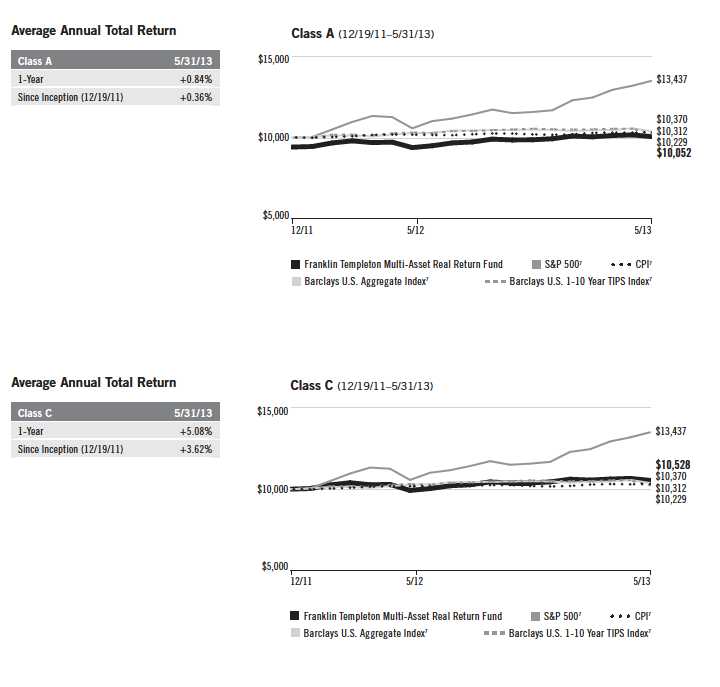
10 | Annual Report
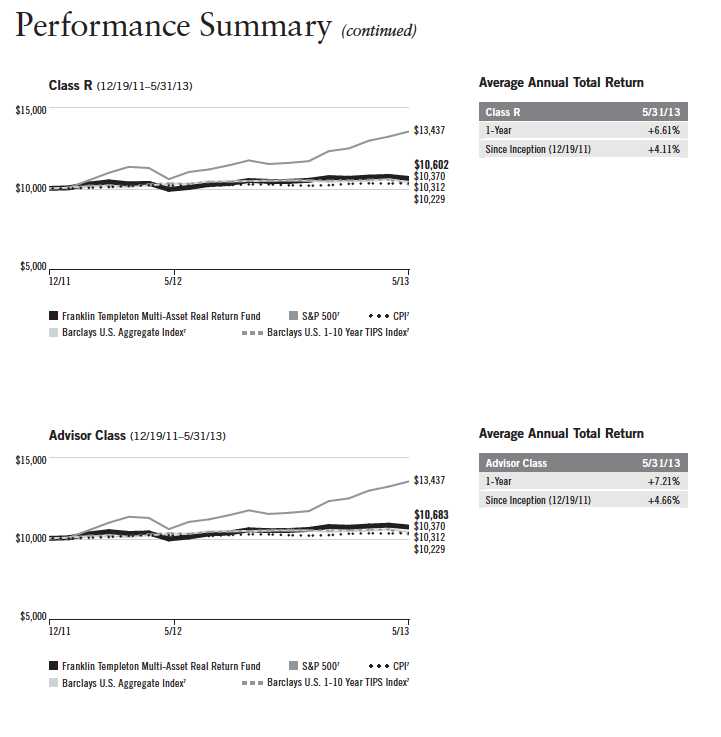
Annual Report | 11
Performance Summary (continued)
Endnotes
All investments involve risks, including possible loss of principal. Generally, investors should be comfortable with fluctuation in the value of their investments, especially over the short term. Stock prices fluctuate, sometimes rapidly and dramatically, due to factors affecting individual companies, particular industries or sectors, or general market conditions. Bond prices generally move in the opposite direction of interest rates. Thus, as prices of bonds in the Fund adjust to a rise in interest rates, the Fund’s share price may decline. Foreign investing carries additional risks such as currency and market volatility and political or social instability, risks that are heightened in developing countries. Because the Fund has a significant investment in Treasury Inflation-Protected Securities (TIPS), it is highly influenced by the TIPS market and the monthly inflation adjustments on these securities. Commodity-linked investments can have heightened risks, including price volatility and less liquidity, and their value may be affected by the performance of broader commodities baskets and markets, as well as supply and demand, weather, tax and other regulatory policies. Because the Fund allocates assets to a variety of investment strategies involving certain risks, the Fund may be subject to those same risks. These risks and others are described more fully in the Fund’s prospectus. The Fund is actively managed but there is no guarantee that the manager’s investment decisions will produce the desired results.
Class C: Class R: | These shares have higher annual fees and expenses than Class A shares. Shares are available to certain eligible investors as described in the prospectus. These shares have higher annual fees and expenses than Class A shares. |
Advisor Class: | Shares are available to certain eligible investors as described in the prospectus. |
1. Fund investment results reflect the expense reduction, without which the results would have been lower. 2. Cumulative total return represents the change in value of an investment over the periods indicated.
3. Average annual total return represents the average annual change in value of an investment over the periods indicated.
4. In accordance with SEC rules, we provide standardized average annual total return information through the latest calendar quarter. 5. These figures represent the value of a hypothetical $10,000 investment in the Fund over the periods indicated.
6. Figures are as stated in the current prospectus and include the effect of acquired fund fees and expenses. In periods of market volatility, assets may decline significantly, causing total annual Fund operating expenses to become higher than the figures shown.
7. Source: © 2013 Morningstar. The Barclays U.S. 1-10 year TIPS Index is the 1-10 year component of the Barclays U.S. TIPS Index and includes inflation-protected notes issued by the U.S. Treasury with a maturity of at least 1 year and less than 10 years. The CPI, calculated by the Bureau of Labor Statistics, is a commonly used measure of the inflation rate. The S&P 500 is a market capitalization-weighted index of 500 stocks designed to measure total U.S. equity market performance. The Barclays U.S. Aggregate Index is a market capitalization-weighted index representing the U.S. investment-grade, fixed-rate taxable bond market with index components for government and corporate, mortgage pass-through, and asset-backed securities. All issues included are SEC-registered, taxable, dollar denominated, non-convertible, must have at least one year to final maturity, and must be rated investment grade (Baa3/BBB-/BBB- or above) using the middle rating of Moody’s, S&P and Fitch, respectively.
12 | Annual Report
Your Fund’s Expenses
As a Fund shareholder, you can incur two types of costs:
- Transaction costs, including sales charges (loads) on Fund purchases; and
- Ongoing Fund costs, including management fees, distribution and service (12b-1) fees, and other Fund expenses. All mutual funds have ongoing costs, sometimes referred to as operating expenses.
The following table shows ongoing costs of investing in the Fund and can help you understand these costs and compare them with those of other mutual funds. The table assumes a $1,000 investment held for the six months indicated.
Actual Fund Expenses
The first line (Actual) for each share class listed in the table provides actual account values and expenses. The “Ending Account Value” is derived from the Fund’s actual return, which includes the effect of Fund expenses.
You can estimate the expenses you paid during the period by following these steps. Of course, your account value and expenses will differ from those in this illustration:
| 1. | Divide your account value by $1,000. |
| If an account had an $8,600 value, then $8,600 ÷ $1,000 = 8.6. | |
| 2. | Multiply the result by the number under the heading “Expenses Paid During Period.” |
| If Expenses Paid During Period were $7.50, then 8.6 x $7.50 = $64.50. |
In this illustration, the estimated expenses paid this period are $64.50.
Hypothetical Example for Comparison with Other Funds
Information in the second line (Hypothetical) for each class in the table can help you compare ongoing costs of investing in the Fund with those of other mutual funds. This information may not be used to estimate the actual ending account balance or expenses you paid during the period. The hypothetical “Ending Account Value” is based on the actual expense ratio for each class and an assumed 5% annual rate of return before expenses, which does not represent the Fund’s actual return. The figure under the heading “Expenses Paid During Period” shows the hypothetical expenses your account would have incurred under this scenario. You can compare this figure with the 5% hypothetical examples that appear in shareholder reports of other funds.
Annual Report | 13
Your Fund’s Expenses (continued)
Please note that expenses shown in the table are meant to highlight ongoing costs and do not reflect any transaction costs, such as sales charges. Therefore, the second line for each class is useful in comparing ongoing costs only, and will not help you compare total costs of owning different funds. In addition, if transaction costs were included, your total costs would have been higher. Please refer to the Fund prospectus for additional information on operating expenses.
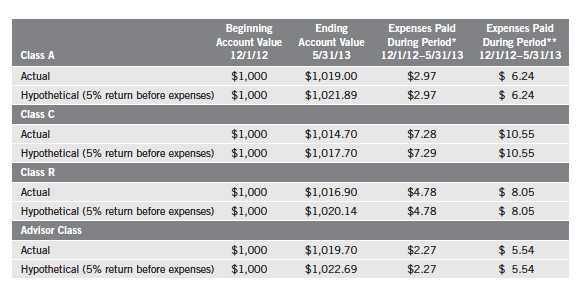
*Expenses are calculated using the most recent six-month expense ratio, excluding expenses of the underlying funds, net of expense waivers, annualized for each class (A: 0.59%; C: 1.45%; R: 0.95%; and Advisor: 0.45%), multiplied by the average account value over the period, multiplied by 182/365 to reflect the one-half year period.
**Expenses are calculated using the most recent six-month expense ratio including expenses of the underlying funds, net of expense waivers, annualized for each class (A: 1.24%; C: 2.1%; R: 1.6%; and Advisor: 1.1%), multiplied by the average account value over the period, multiplied by 182/365 to reflect the one-half year period.
14 | Annual Report
Franklin Templeton Fund Allocator Series
Financial Highlights
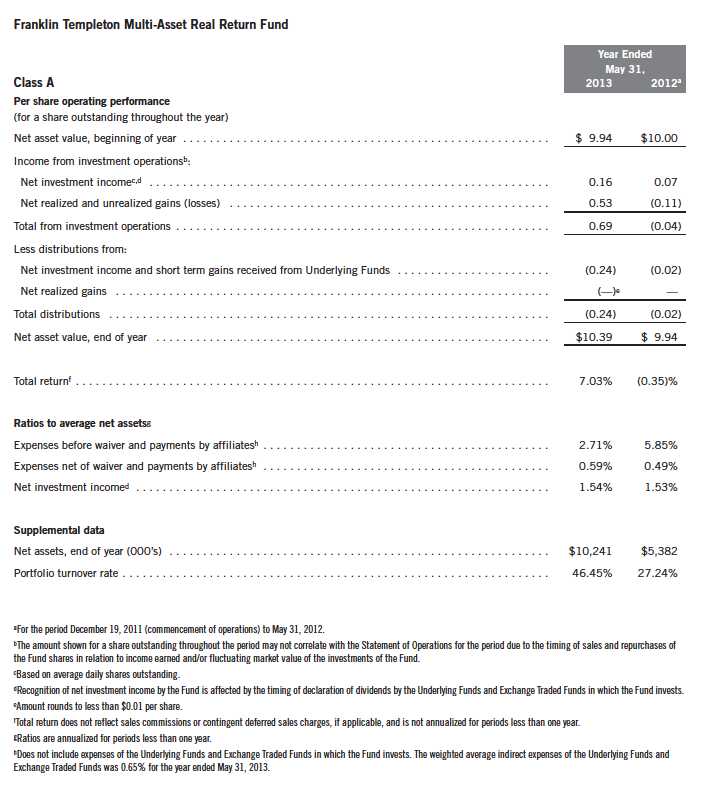
Annual Report | The accompanying notes are an integral part of these financial statements. | 15
Franklin Templeton Fund Allocator Series
Financial Highlights (continued)
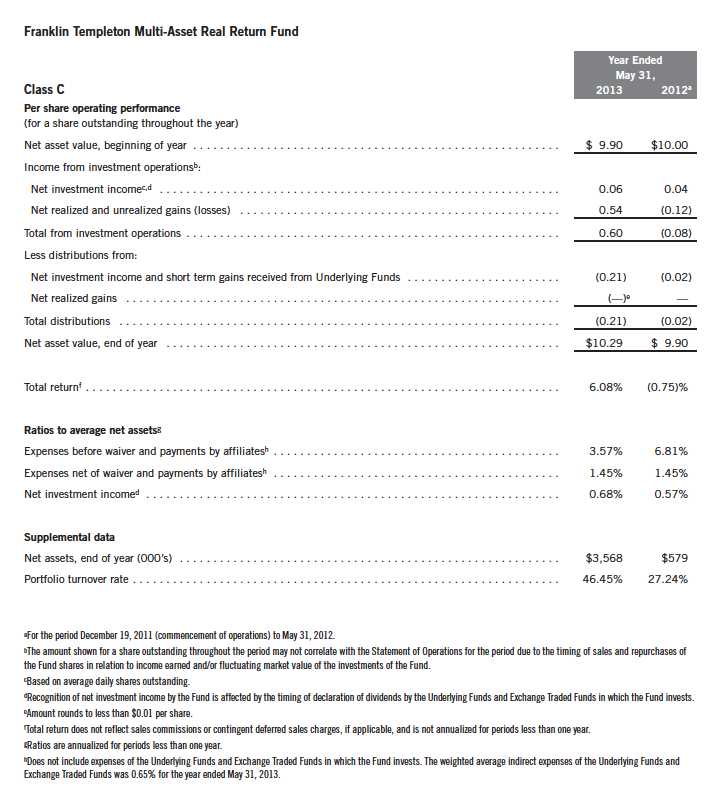
16 | The accompanying notes are an integral part of these financial statements. | Annual Report
Franklin Templeton Fund Allocator Series
Financial Highlights (continued)
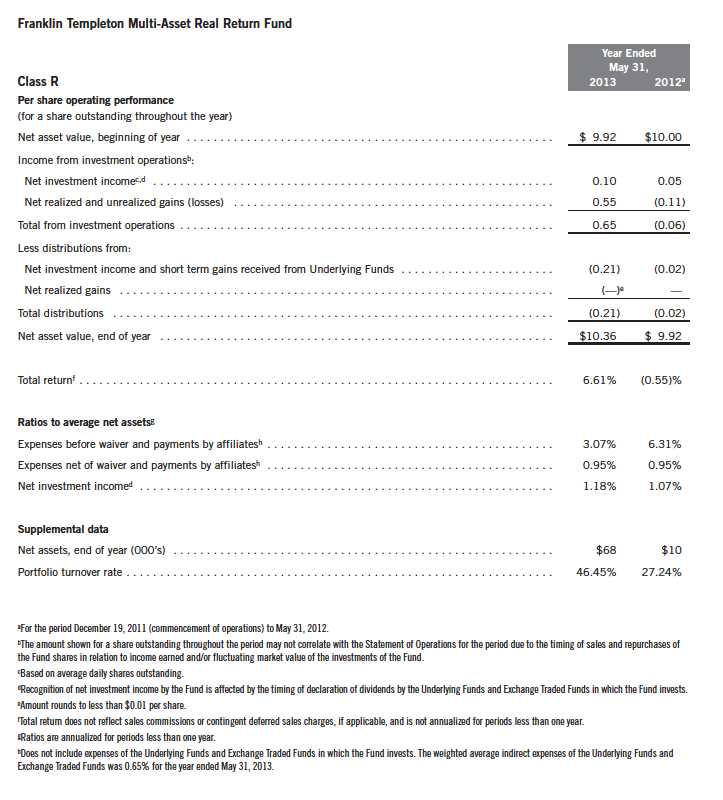
Annual Report | The accompanying notes are an integral part of these financial statements. | 17
Franklin Templeton Fund Allocator Series
Financial Highlights (continued)
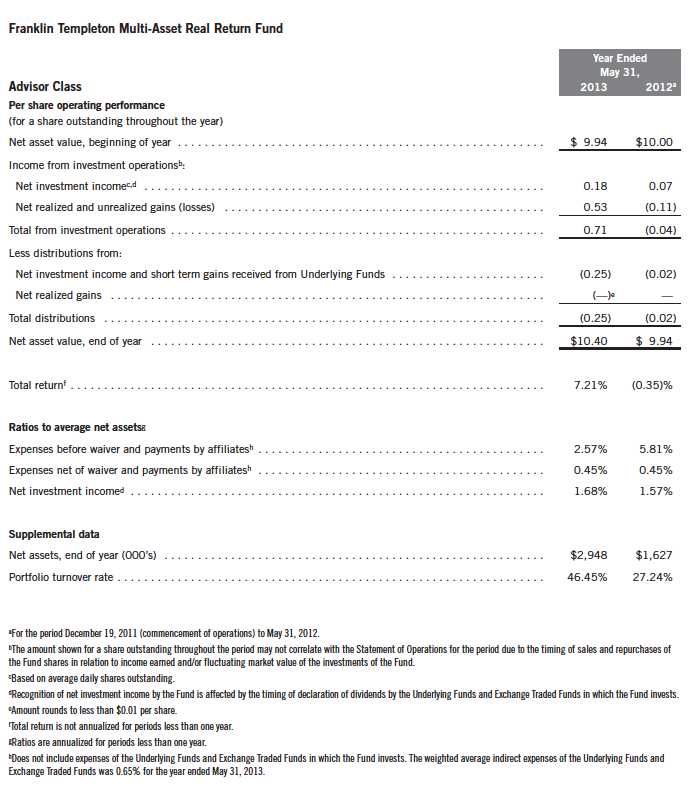
18 | The accompanying notes are an integral part of these financial statements. | Annual Report
Franklin Templeton Fund Allocator Series
Statement of Investments, May 31, 2013
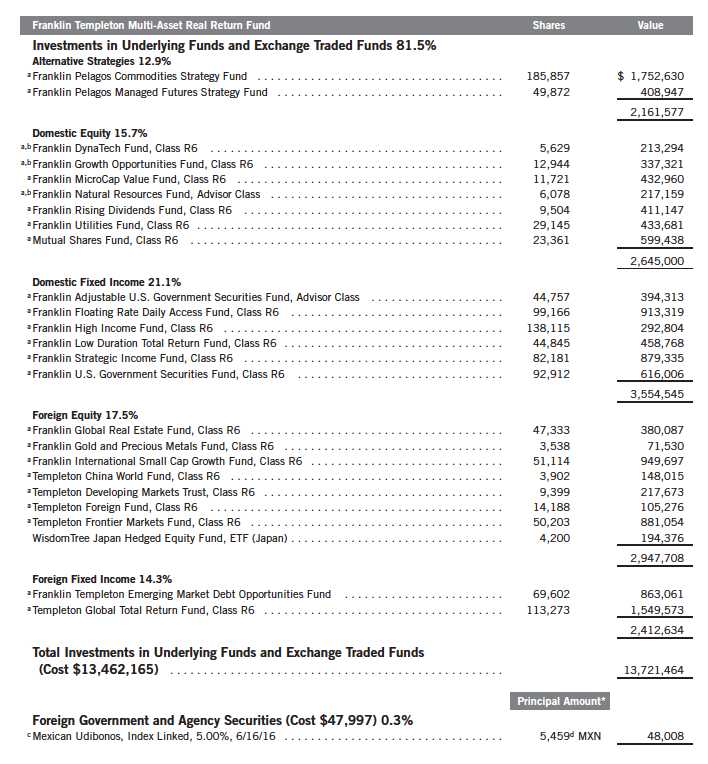
Annual Report | 19
Franklin Templeton Fund Allocator Series
Statement of Investments, May 31, 2013 (continued)
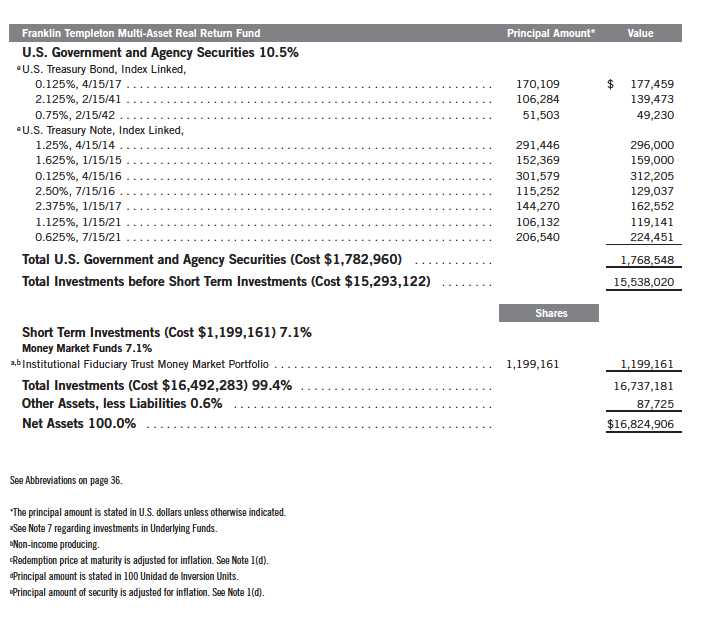
20 | The accompanying notes are an integral part of these financial statements. | Annual Report
Franklin Templeton Fund Allocator Series
Financial Statements
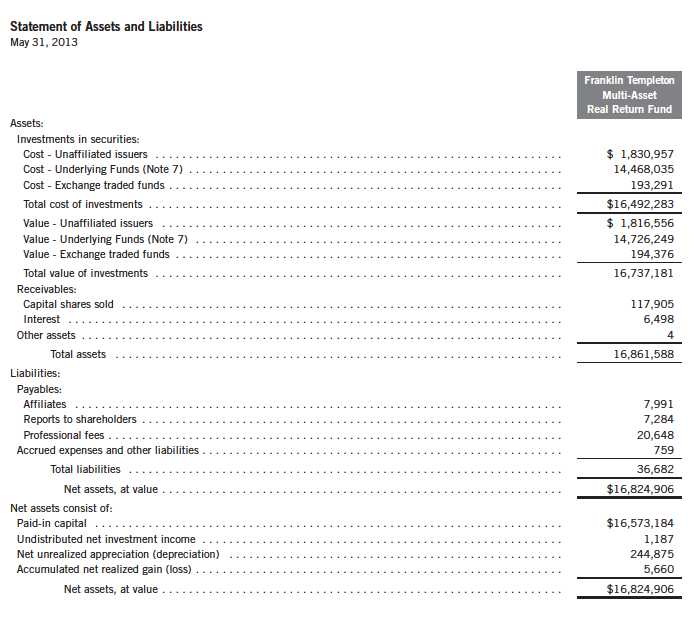
Annual Report | The accompanying notes are an integral part of these financial statements. | 21
Franklin Templeton Fund Allocator Series
Financial Statements (continued)
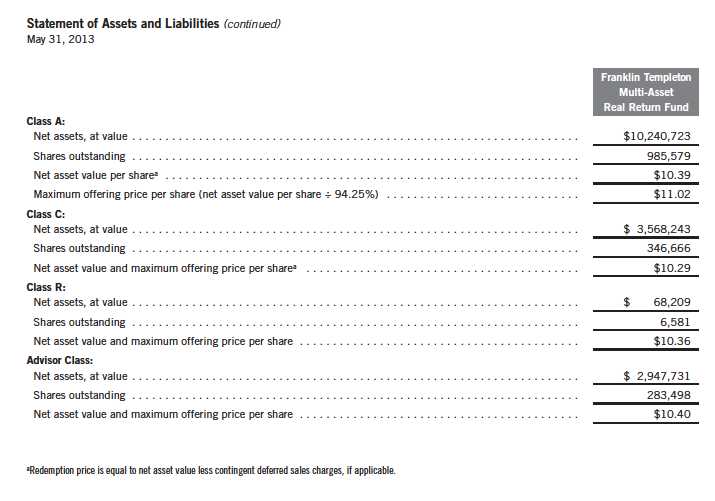
22 | The accompanying notes are an integral part of these financial statements. | Annual Report
Franklin Templeton Fund Allocator Series
Financial Statements (continued)
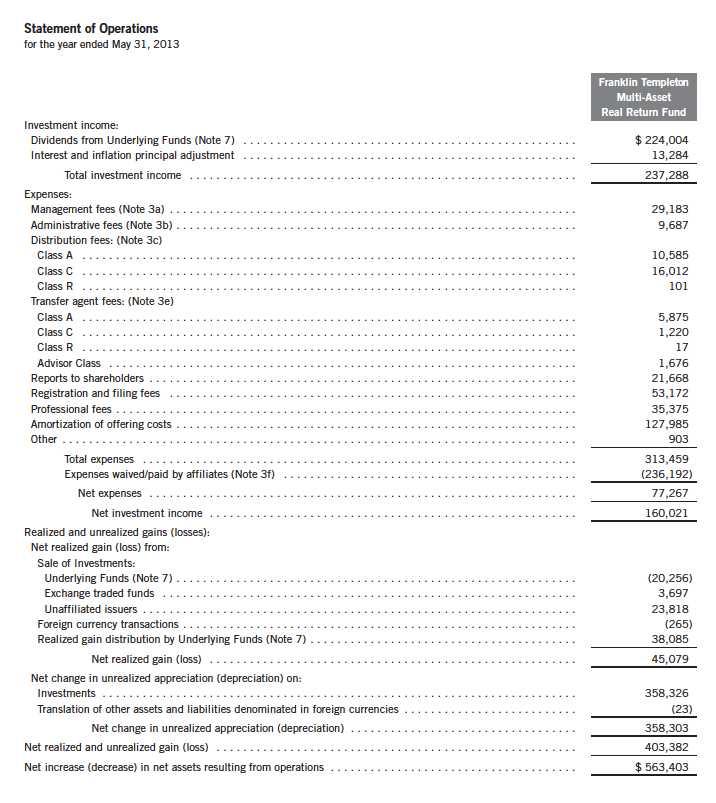
Annual Report | The accompanying notes are an integral part of these financial statements. | 23
Franklin Templeton Fund Allocator Series
Financial Statements (continued)
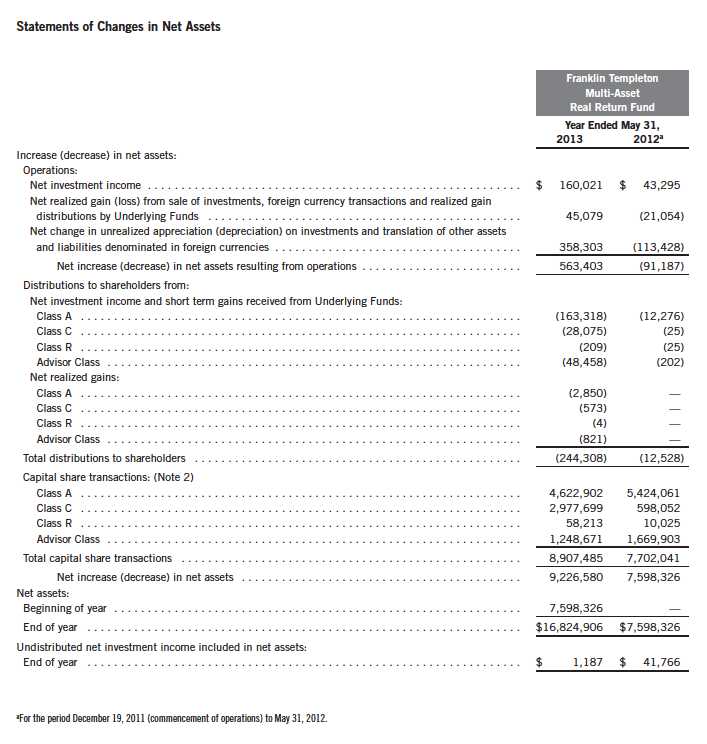
24 | The accompanying notes are an integral part of these financial statements. | Annual Report
Franklin Templeton Fund Allocator Series
Notes to Financial Statements
Franklin Templeton Multi-Asset Real Return Fund
1. ORGANIZATION AND SIGNIFICANT ACCOUNTING POLICIES
Franklin Templeton Fund Allocator Series (Trust) is registered under the Investment Company Act of 1940, as amended, (1940 Act) as an open-end investment company, consisting of ten separate funds. The Franklin Templeton Multi-Asset Real Return Fund (Fund) is included in this report. The financial statements of the remaining funds in the Trust are presented separately. The Fund invests primarily in Franklin Templeton mutual funds (Underlying Funds). The Fund offers four classes of shares: Class A, Class C, Class R, and Advisor Class. Each class of shares differs by its initial sales load, contingent deferred sales charges, voting rights on matters affecting a single class, its exchange privilege and fees primarily due to differing arrangements for distribution and transfer agent fees.
The following summarizes the Funds’ significant accounting policies.
a. Financial Instrument Valuation
The Fund’s investments in financial instruments are carried at fair value daily. Fair value is the price that would be received to sell an asset or paid to transfer a liability in an orderly transaction between market participants on the measurement date. Under procedures approved by the Trust’s Board of Trustees (the Board), the Fund’s administrator, investment manager and other affiliates have formed the Valuation and Liquidity Oversight Committee (VLOC). The VLOC provides administration and oversight of the Fund’s valuation policies and procedures, which are approved annually by the Board. Among other things, these procedures allow the Fund to utilize independent pricing services, quotations from securities and financial instrument dealers, and other market sources to determine fair value. Investments in the Underlying Funds are valued at their closing net asset value each trading day. Exchange traded funds (ETFs) listed in an exchange or on the NASDAQ National Market System are valued at the last quoted sale price or the official closing price of the day, respectively.
Debt securities generally trade in the over-the-counter market rather than on a securities exchange. The Fund’s pricing services use multiple valuation techniques to determine fair value. In instances where sufficient market activity exists, the pricing services may utilize a market-based approach through which quotes from market makers are used to determine fair value. In instances where sufficient market activity may not exist or is limited, the pricing services also utilize proprietary valuation models which may consider market characteristics such as benchmark yield curves, credit spreads, estimated default rates, anticipated market interest rate volatility, coupon rates, anticipated timing of principal repayments, underlying collateral, and other unique security features in order to estimate the relevant cash flows, which are then discounted to calculate the fair value. Securities denominated in a foreign currency are converted into their U.S. dollar equivalent at the foreign exchange rate in effect at the close of the NYSE on the date that the values of the foreign debt securities are determined.
Annual Report | 25
Franklin Templeton Fund Allocator Series
Notes to Financial Statements (continued)
Franklin Templeton Multi-Asset Real Return Fund
| 1. | ORGANIZATION AND SIGNIFICANT ACCOUNTING POLICIES (continued) |
| a. | Financial Instrument Valuation (continued) |
The Fund has procedures to determine the fair value of financial instruments for which market prices are not reliable or readily available. Under these procedures, the VLOC convenes on a regular basis to review such financial instruments and considers a number of factors, including significant unobservable valuation inputs, when arriving at fair value. The VLOC primarily employs a market-based approach which may use related or comparable assets or liabilities, recent transactions, market multiples, book values, and other relevant information for the investment to determine the fair value of the investment. An income-based valuation approach may also be used in which the anticipated future cash flows of the investment are discounted to calculate fair value. Discounts may also be applied due to the nature or duration of any restrictions on the disposition of the investments. Due to the inherent uncertainty of valuations of such investments, the fair values may differ significantly from the values that would have been used had an active market existed. The VLOC employs various methods for calibrating these valuation approaches including a regular review of key inputs and assumptions, transactional back-testing or disposition analysis, and reviews of any related market activity.
b. Foreign Currency Translation
Portfolio securities and other assets and liabilities denominated in foreign currencies are translated into U.S. dollars based on the exchange rate of such currencies against U.S. dollars on the date of valuation. The Fund may enter into foreign currency exchange contracts to facilitate transactions denominated in a foreign currency. Purchases and sales of securities, income and expense items denominated in foreign currencies are translated into U.S. dollars at the exchange rate in effect on the transaction date. Portfolio securities and assets and liabilities denominated in foreign currencies contain risks that those currencies will decline in value relative to the U.S. dollar. Occasionally, events may impact the availability or reliability of foreign exchange rates used to convert the U.S. dollar equivalent value. If such an event occurs, the foreign exchange rate will be valued at fair value using procedures established and approved by the Board.
The Fund does not separately report the effect of changes in foreign exchange rates from changes in market prices on securities held. Such changes are included in net realized and unrealized gain or loss from investments on the Statement of Operations.
Realized foreign exchange gains or losses arise from sales of foreign currencies, currency gains or losses realized between the trade and settlement dates on securities transactions and the difference between the recorded amounts of dividends, interest, and foreign withholding taxes and the U.S. dollar equivalent of the amounts actually received or paid. Net unrealized foreign exchange gains and losses arise from changes in foreign exchange rates on foreign denominated assets and liabilities other than investments in securities held at the end of the reporting period.
26 | Annual Report
Franklin Templeton Fund Allocator Series
Notes to Financial Statements (continued)
Franklin Templeton Multi-Asset Real Return Fund
| 1. | ORGANIZATION AND SIGNIFICANT ACCOUNTING POLICIES (continued) |
| c. | Income and Deferred Taxes |
It is the Fund’s policy to qualify as a regulated investment company under the Internal Revenue Code. The Fund intends to distribute to shareholders substantially all of its taxable income and net realized gains to relieve it from federal income and excise taxes. As a result, no provision for U.S. federal income taxes is required.
The Fund may be subject to foreign taxation related to income received, capital gains on the sale of securities and certain foreign currency transactions in the foreign jurisdictions in which it invests. Foreign taxes, if any, are recorded based on the tax regulations and rates that exist in the foreign markets in which the Fund invests. When a capital gain tax is determined to apply the Fund records an estimated deferred tax liability in an amount that would be payable if the securities were disposed of on the valuation date.
The Fund recognizes the tax benefits of uncertain tax positions only when the position is “more likely than not” to be sustained upon examination by the tax authorities based on the technical merits of the tax position. As of May 31, 2013, and for all open tax years, the Fund has determined that no liability for unrecognized tax benefits is required in the Fund’s financial statements related to uncertain tax positions taken on a tax return (or expected to be taken on future tax returns). Open tax years are those that remain subject to examination and are based on each tax jurisdiction statute of limitation.
d. Security Transactions, Investment Income, Expenses and Distributions
Security transactions are accounted for on trade date. Realized gains and losses on security transactions are determined on a specific identification basis. Interest income and estimated expenses are accrued daily. Amortization of premium and accretion of discount on debt securities are included in interest income. Dividend income, and realized gain distributions by Underlying Funds, and ETFs are recorded on the ex-dividend date. Distributions to shareholders are recorded on the ex-dividend date and are determined according to income tax regulations (tax basis). Distributable earnings determined on a tax basis may differ from earnings recorded in accordance with accounting principles generally accepted in the United States of America. These differences may be permanent or temporary. Permanent differences are reclassified among capital accounts to reflect their tax character. These reclassifications have no impact on net assets or the results of operations. Temporary differences are not reclassified, as they may reverse in subsequent periods.
Common expenses incurred by the Trust are allocated among the funds based on the ratio of net assets of each fund to the combined net assets of the Trust. Fund specific expenses are charged directly to the fund that incurred the expense.
Annual Report | 27
Franklin Templeton Fund Allocator Series
Notes to Financial Statements (continued)
Franklin Templeton Multi-Asset Real Return Fund
| 1. | ORGANIZATION AND SIGNIFICANT ACCOUNTING POLICIES (continued) |
| d. | Security Transactions, Investment Income, Expenses and Distributions (continued) |
The Fund indirectly bears its proportionate share of expenses from the Underlying Funds. Since the Underlying Funds have varied expense levels and the Fund may own different proportions of the Underlying Funds at different times, the amount of expenses incurred indirectly by the Fund will vary.
Realized and unrealized gains and losses and net investment income, not including class specific expenses, are allocated daily to each class of shares based upon the relative proportion of net assets of each class. Differences in per share distributions, by class, are generally due to differences in class specific expenses.
Inflation-indexed bonds are adjusted for inflation through periodic increases or decreases in the security’s interest accruals, face amount, or principal redemption value, by amounts corresponding to the rate of inflation as measured by an index. Any increase or decrease in the face amount or principal redemption value will be included as inflation principal adjustments on the Statement of Operations.
e. Offering Costs
Offering costs are amortized on a straight line basis over twelve months.
f. Accounting Estimates
The preparation of financial statements in accordance with accounting principles generally accepted in the United States of America requires management to make estimates and assumptions that affect the reported amounts of assets and liabilities at the date of the financial statements and the amounts of income and expenses during the reporting period. Actual results could differ from those estimates.
g. Guarantees and Indemnifications
Under the Trust’s organizational documents, its officers and trustees are indemnified by the Trust against certain liabilities arising out of the performance of their duties to the Trust. Additionally, in the normal course of business, the Trust, on behalf of the Fund, enters into contracts with service providers that contain general indemnification clauses. The Trust’s maximum exposure under these arrangements is unknown as this would involve future claims that may be made against the Trust that have not yet occurred. Currently, the Trust expects the risk of loss to be remote.
28 | Annual Report
Franklin Templeton Fund Allocator Series
Notes to Financial Statements (continued)
Franklin Templeton Multi-Asset Real Return Fund
2. SHARES OF BENEFICIAL INTEREST
At May 31, 2013, there were an unlimited number of shares authorized (without par value).
Transactions in the Fund’s shares were as follows:
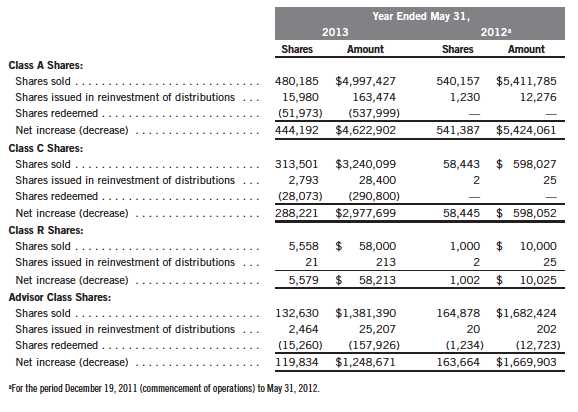
3. TRANSACTIONS WITH AFFILIATES
Franklin Resources, Inc. is the holding company for various subsidiaries that together are referred to as Franklin Templeton Investments. Certain officers and trustees of the Trust are also officers and/or directors/trustees of certain of the Underlying Funds and of the following subsidiaries:

Annual Report | 29
Franklin Templeton Fund Allocator Series
Notes to Financial Statements (continued)
Franklin Templeton Multi-Asset Real Return Fund
| 3. | TRANSACTIONS WITH AFFILIATES (continued) |
| a. | Management Fees |
The Fund pays an investment management fee to Advisers of 0.35% per year of the average daily net assets of the Fund.
Effective May 1, 2013, the Fund combined its investment management and administration agreements as approved by the Board. The fees paid under the combined agreement do not exceed the aggregate fees that were paid under the separate agreements.
Prior to May 1, 2013, the Fund paid fees to Advisers of 0.25% per year of the average daily net assets of the Fund.
Under a subadvisory agreement, FT Institutional, an affiliate of Advisers, provides subadvisory services to the Fund. The subadvisory fee is paid by Advisers based on the average daily net assets, and is not an additional expense of the Fund.
b. Administrative Fees
Effective May 1, 2013, following the combining of the investment management and administrative agreements as approved by the Board, under an agreement with Advisers, FT Services provides administrative services to the Fund. The fee is paid by Advisers based on the average daily net assets, and is not an additional expense of the Fund.
Prior to May 1, 2013, the Fund paid administrative fees to FT Services of 0.10% per year of the average daily net assets.
c. Distribution Fees
The Board has adopted distribution plans for each share class, with the exception of Advisor Class shares, pursuant to Rule 12b-1 under the 1940 Act. Distribution fees are not charged on shares held by affiliates. Under the Fund’s Class A reimbursement distribution plan, the Fund reimburses Distributors for costs incurred in connection with the servicing, sale and distribution of the Fund’s shares up to the maximum annual plan rate. Under the Class A reimbursement distribution plan, costs exceeding the maximum for the current plan year cannot be reimbursed in subsequent periods. In addition, under the Fund’s Class C and R compensation distribution plans, the Fund pays Distributors for costs incurred in connection with the servicing, sale and distribution of the Fund’s shares up to the maximum annual plan rate for each class.
The maximum annual plan rates, based on the average daily net assets, for each class, are as follows:

Franklin Templeton Fund Allocator Series
Notes to Financial Statements (continued)
Franklin Templeton Multi-Asset Real Return Fund
| 3. | TRANSACTIONS WITH AFFILIATES (continued) |
| d. | Sales Charges/Underwriting Agreements |
Front-end sales charges and contingent deferred sales charges (CDSC) do not represent expenses of the Fund. These charges are deducted from the proceeds of sales of Fund shares prior to investment or from redemption proceeds prior to remittance, as applicable. Distributors has advised the Fund of the following commission transactions related to the sales and redemptions of the Fund’s shares for the period:

e. Transfer Agent Fees
Each class of shares pays transfer agent fees to Investor Services for its performance of shareholder servicing obligations and reimburses Investor Services for out of pocket expenses incurred, including shareholding servicing fees paid to third parties. These fees are allocated daily to such classes based upon the relative proportion of net assets.
For the year ended May 31, 2013, the Fund paid transfer agent fees of $8,788 of which $5,515 was retained by Investor Services.
f. Waiver and Expense Reimbursements
Advisers and FT Services have contractually agreed in advance to waive or limit their respective fees and to assume as their own expense certain expenses otherwise payable by the Fund so that the expenses excluding distribution fees, and acquired fund fees and expenses for each Class of the Fund do not exceed 0.45% (other than certain non-routine expenses or costs, including those relating to litigation, indemnification, reorganizations, and liquidations) until September 30, 2013.
g. Other Affiliated Transactions
At May 31, 2013, Advisers owned 31.51% of the Fund’s outstanding shares.
4. EXPENSE OFFSET ARRANGEMENT
The Fund has entered into an arrangement with its custodian whereby credits realized as a result of uninvested cash balances are used to reduce a portion of the Fund’s custodian expenses. During the year ended May 31, 2013, there were no credits earned.
Annual Report | 31
Franklin Templeton Fund Allocator Series
Notes to Financial Statements (continued)
Franklin Templeton Multi-Asset Real Return Fund
5. INCOME TAXES
During the year ended May 31, 2013, the Fund utilized $10,258 of capital loss carryforwards.
The tax character of distributions paid during the years ended May 31, 2013 and 2012 was as follows:

At May 31, 2013, the cost of investments, net unrealized appreciation (depreciation), undistributed ordinary income and undistributed long term capital gains for income tax purposes were as follows:
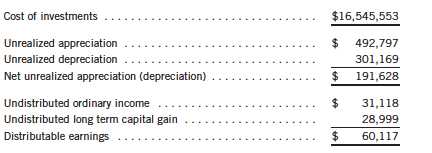
Differences between income and/or capital gains as determined on a book basis and a tax basis are primarily due to differing treatments of bond discounts and premiums, offering costs, short term capital gains distributions from Underlying Funds and wash sales.
6. INVESTMENT TRANSACTIONS
Purchases and sales of investments (excluding short term securities) for the year ended May 31, 2013, aggregated $12,875,716 and $4,898,025, respectively.
7. INVESTMENT IN UNDERLYING FUNDS
The Fund invests primarily in the Underlying Funds which are managed by Advisers or an affiliate of Advisers. The Fund does not invest in the Underlying Funds for the purpose of exercising a controlling influence over the management or policies. Management fees paid by the Fund are reduced on assets invested in the Institutional Fiduciary Trust Money Market Portfolio (Sweep Money Fund) in an amount not to exceed the management and administrative fees paid by the Sweep Money Fund.
32 | Annual Report
Franklin Templeton Fund Allocator Series
Notes to Financial Statements (continued)
Franklin Templeton Multi-Asset Real Return Fund
7. INVESTMENT IN UNDERLYING FUNDS (continued)
Investments in Underlying Funds for the year ended May 31, 2013, were as follows:
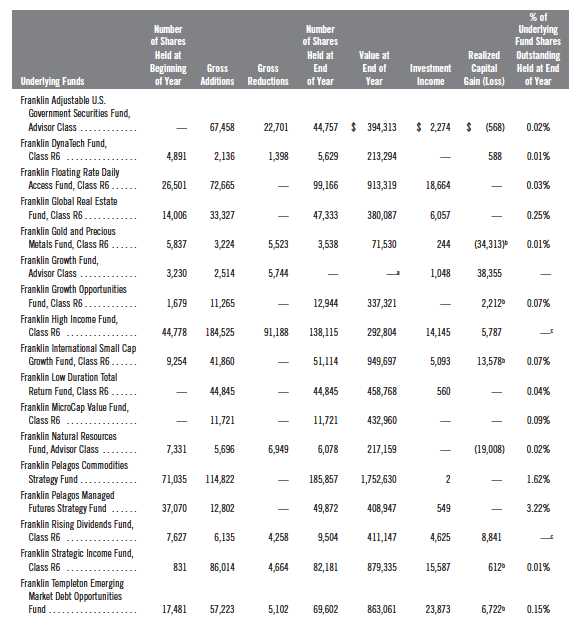
Annual Report | 33
Franklin Templeton Fund Allocator Series
Notes to Financial Statements (continued)
Franklin Templeton Multi-Asset Real Return Fund
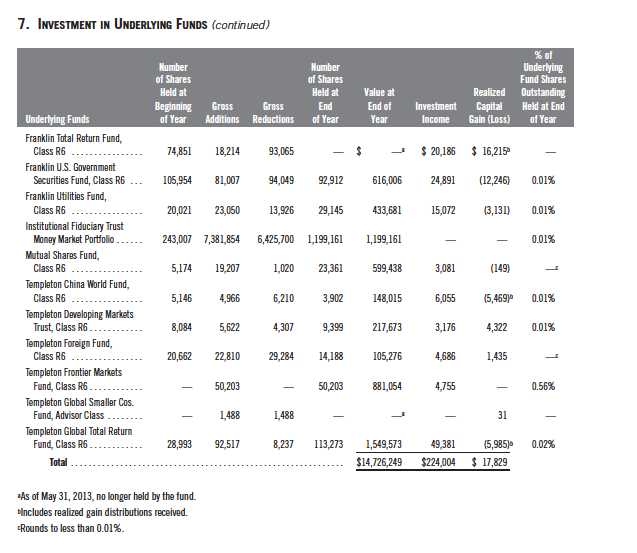
8. CREDIT FACILITY
The Fund, together with other U.S. registered and foreign investment funds (collectively, Borrowers), managed by Franklin Templeton Investments, are borrowers in a joint syndicated senior unsecured credit facility totaling $1.5 billion (Global Credit Facility) which matures on January 17, 2014. This Global Credit Facility provides a source of funds to the Borrowers for temporary and emergency purposes, including the ability to meet future unanticipated or unusually large redemption requests.
34 | Annual Report
Franklin Templeton Fund Allocator Series
Notes to Financial Statements (continued)
Franklin Templeton Multi-Asset Real Return Fund
8. CREDIT FACILITY (continued)
Under the terms of the Global Credit Facility, the Fund shall, in addition to interest charged on any borrowings made by the Fund and other costs incurred by the Fund, pay its share of fees and expenses incurred in connection with the implementation and maintenance of the Global Credit Facility, based upon its relative share of the aggregate net assets of all of the Borrowers, including an annual commitment fee of 0.07% based upon the unused portion of the Global Credit Facility. These fees are reflected in other expenses on the Statement of Operations. During the year ended May 31, 2013, the Fund did not use the Global Credit Facility.
9. FAIR VALUE MEASUREMENTS
The Fund follows a fair value hierarchy that distinguishes between market data obtained from independent sources (observable inputs) and the Fund’s own market assumptions (unobservable inputs). These inputs are used in determining the value of the Fund’s financial instruments and are summarized in the following fair value hierarchy:
- Level 1 – quoted prices in active markets for identical financial instruments
- Level 2 – other significant observable inputs (including quoted prices for similar financial instruments, interest rates, prepayment speed, credit risk, etc.)
- Level 3 – significant unobservable inputs (including the Fund’s own assumptions in determining the fair value of financial instruments)
The inputs or methodology used for valuing financial instruments are not an indication of the risk associated with investing in those financial instruments.
For movements between the levels within the fair value hierarchy, the Fund has adopted a policy of recognizing the transfers as of the date of the underlying event which caused the movement.
A summary of inputs used as of May 31, 2013, in valuing the Fund’s assets carried at fair value, is as follows:

Annual Report | 35
Franklin Templeton Fund Allocator Series
Notes to Financial Statements (continued)
Franklin Templeton Multi-Asset Real Return Fund
10. NEW ACCOUNTING PRONOUNCEMENTS
In December 2011, the Financial Accounting Standards Board (FASB) issued Accounting Standards Update (ASU) No. 2011-11, Balance Sheet (Topic 210): Disclosures about Offsetting Assets and Liabilities. The amendments in the ASU enhance disclosures about offsetting of financial assets and liabilities to enable investors to understand the effect of these arrangements on a fund’s financial position. In January 2013, FASB issued ASU No. 2013-01, Balance Sheet (Topic 210): Clarifying the Scope of Disclosures about Offsetting Assets and Liabilities. The amendments in ASU No. 2013-01 clarify the intended scope of disclosures required by ASU No. 2011-11. These ASUs are effective for interim and annual reporting periods beginning on or after January 1, 2013. The Fund believes the adoption of these ASUs will not have a material impact on its financial statements.
In June 2013 FASB issued ASU No. 2013-08, Investment Companies (Topic 946): Amendments to the Scope, Measurement, and Disclosure Requirements. The ASU modifies the criteria used in defining an investment company under U.S. Generally Accepted Accounting Principles and also sets forth certain measurement and disclosure requirements. Under the ASU, an entity that is regulated under the 1940 Act automatically qualifies as an investment company. The ASU is effective for interim and annual reporting periods beginning after December 15, 2013. The Fund is currently reviewing the requirements and believes the adoption of this ASU will not have a material impact on its financial statements.
11. SUBSEQUENT EVENTS
The Fund has evaluated subsequent events through the issuance of the financial statements and determined that no events have occurred that require disclosure.

36 | Annual Report
Franklin Templeton Fund Allocator Series
Report of Independent Registered Public Accounting Firm
To the Board of Trustees and Shareholders of Franklin Templeton Multi-Asset Real Return Fund
In our opinion, the accompanying statement of assets and liabilities, including the statement of investments, and the related statements of operations and of changes in net assets and the financial highlights present fairly, in all material respects, the financial position of Franklin Templeton Multi-Asset Real Return Fund (one of the portfolios constituting Franklin Templeton Fund Allocator Series), hereafter referred to as the “Fund” at May 31, 2013, the results of its operations for the year then ended, the changes in its net assets and the financial highlights for the periods presented, in conformity with accounting principles generally accepted in the United States of America. These financial statements and financial highlights (hereafter referred to as “financial statements”) are the responsibility of the Fund’s management. Our responsibility is to express an opinion on these financial statements based on our audits. We conducted our audits of these financial statements in accordance with the standards of the Public Company Accounting Oversight Board (United States). Those standards require that we plan and perform the audit to obtain reasonable assurance about whether the financial statements are free of material misstatement. An audit includes examining, on a test basis, evidence supporting the amounts and disclosures in the financial statements, assessing the accounting principles used and significant estimates made by management, and evaluating the overall financial statement presentation. We believe that our audits, which included confirmation of securities at May 31, 2013 by correspondence with the custodian, transfer agent and brokers, provide a reasonable basis for our opinion.
PricewaterhouseCoopers LLP
San Francisco, California
July 19, 2013
Annual Report | 37
Franklin Templeton Fund Allocator Series
Tax Information (unaudited)
Franklin Templeton Multi-Asset Real Return Fund
Under Section 854(b)(1)(A) of the Internal Revenue Code (Code), the Fund hereby reports 7.91% of the ordinary income dividends as income qualifying for the dividends received deduction for the fiscal year ended May 31, 2013.
Under Section 854(b)(1)(B) of the Internal Revenue Code (Code), the Fund hereby reports the maximum amount allowable but no less than $119,207 as qualified dividends for purposes of the maximum rate under Section 1(h)(11) of the Code for the fiscal year ended May 31, 2013. Distributions, including qualified dividend income, paid during calendar year 2013 will be reported to shareholders on Form 1099-DIV by mid-February 2014. Shareholders are advised to check with their tax advisors for information on the treatment of these amounts on their individual income tax returns.
During the fiscal year ended May 31, 2013, the Fund, a qualified fund of funds under Section 852(g)(2) of Code, received an allocation of foreign taxes paid from one or more of its underlying funds. As shown in the table below, the Fund hereby reports to shareholders the foreign source income and foreign taxes paid by underlying funds, pursuant to Section 853 of the Code. This written statement will allow shareholders of record on December 27, 2012, to treat their proportionate share of foreign taxes paid by the underlying funds as having been paid directly by them. The shareholder shall consider these amounts as foreign taxes paid in the tax year in which they receive the Fund distribution.
The following table provides a detailed analysis of foreign tax paid, and foreign source income, and foreign qualified dividends as reported by the Fund, to Class A, Class C, Class R, and Advisor Class shareholders of record.

Foreign Tax Paid Per Share (Column 1) is the amount per share available to you, as a tax credit (assuming you held your shares in the Fund for a minimum of 16 days during the 31-day period beginning 15 days before the ex-dividend date of the Fund’s distribution to which the foreign taxes relate), or, as a tax deduction.
Foreign Source Income Per Share (Column 2) is the amount per share of income dividends attributable to foreign securities held by the underlying funds, plus any foreign taxes withheld on these dividends. The amounts reported include foreign source qualified dividends that have not been adjusted for the rate differential applicable to such dividend income.1
38 | Annual Report
Franklin Templeton Fund Allocator Series
Tax Information (unaudited) (continued)
Franklin Templeton Multi-Asset Real Return Fund
Foreign Qualified Dividends Per Share (Column 3) is the amount per share of foreign source qualified dividends, plus any foreign taxes withheld on these dividends. These amounts represent the portion of the Foreign Source Income reported to you in column 2 that were derived from qualified foreign securities held by the underlying funds.1
In February 2013, shareholders received Form 1099-DIV which included their share of taxes paid and foreign source income distributed during the calendar year 2012. The Foreign Source Income reported on Form 1099-DIV was not adjusted for the rate differential on foreign source qualified dividend income. Shareholders are advised to check with their tax advisors for information on the treatment of these amounts on their 2012 individual income tax returns.
1Qualified dividends are taxed at reduced long term capital gains tax rates. In determining the amount of foreign tax credit that may be applied against the U.S. tax liability of individuals receiving foreign source qualified dividends, adjustments may be required to the foreign tax credit limitation calculation to reflect the rate differential applicable to such dividend income. The rules however permit certain individuals to elect not to apply the rate differential adjustments for capital gains and/or dividends for any taxable year. Please consult your tax advisor and the instructions to Form 1116 for more information.
Annual Report | 39
Franklin Templeton Fund Allocator Series
Board Members and Officers
The name, year of birth and address of the officers and board members, as well as their affiliations, positions held with the Trust, principal occupations during at least the past five years and number of portfolios overseen in the Franklin Templeton Investments fund complex are shown below. Generally, each board member serves until that person’s successor is elected and qualified.
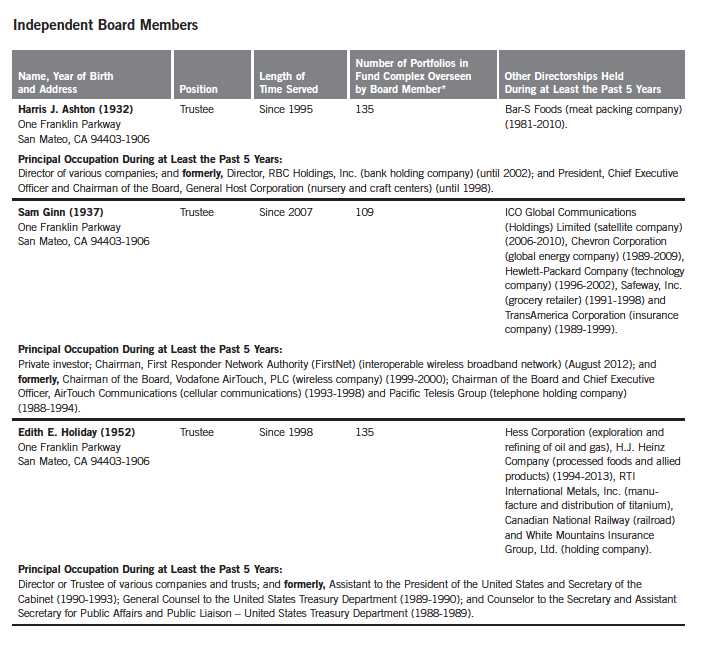
40 | Annual Report
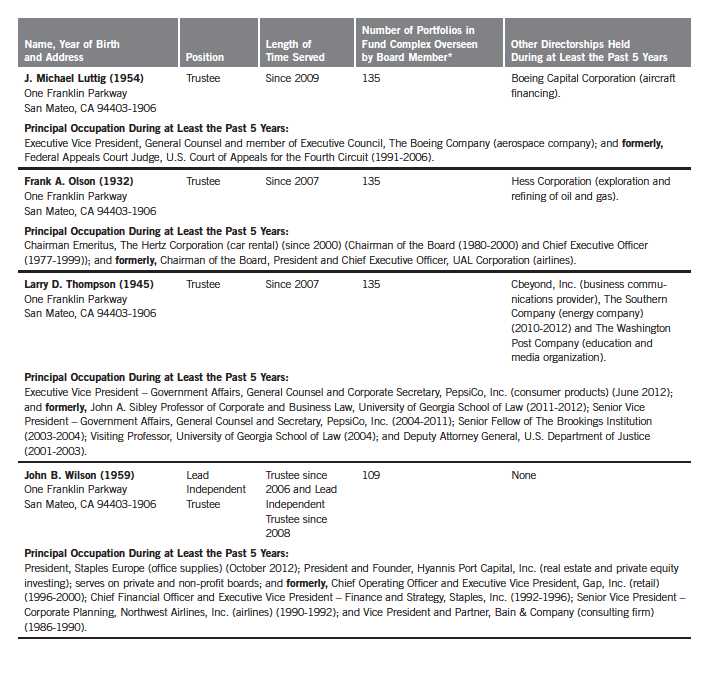
Annual Report | 41

42 | Annual Report
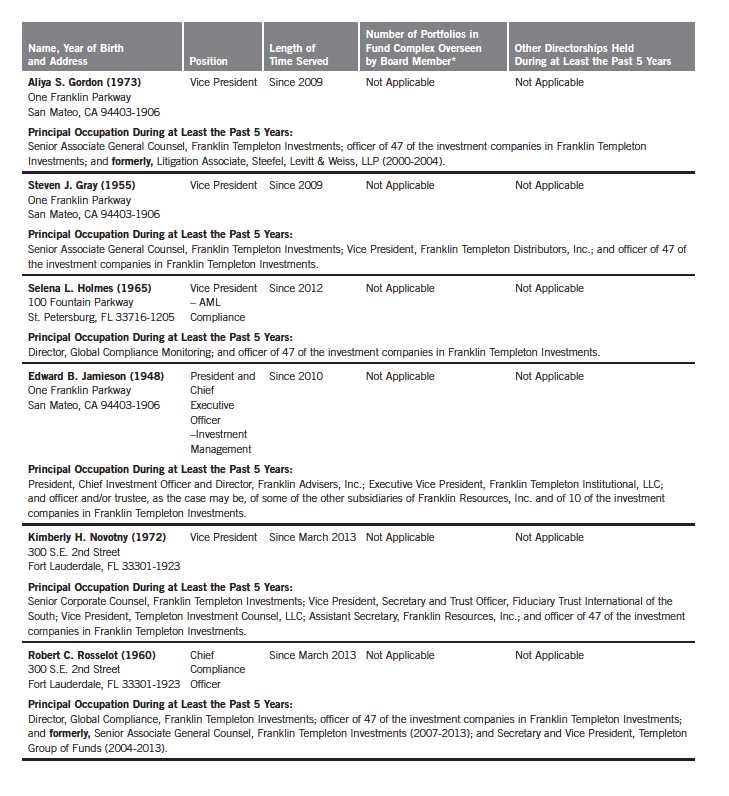
Annual Report | 43
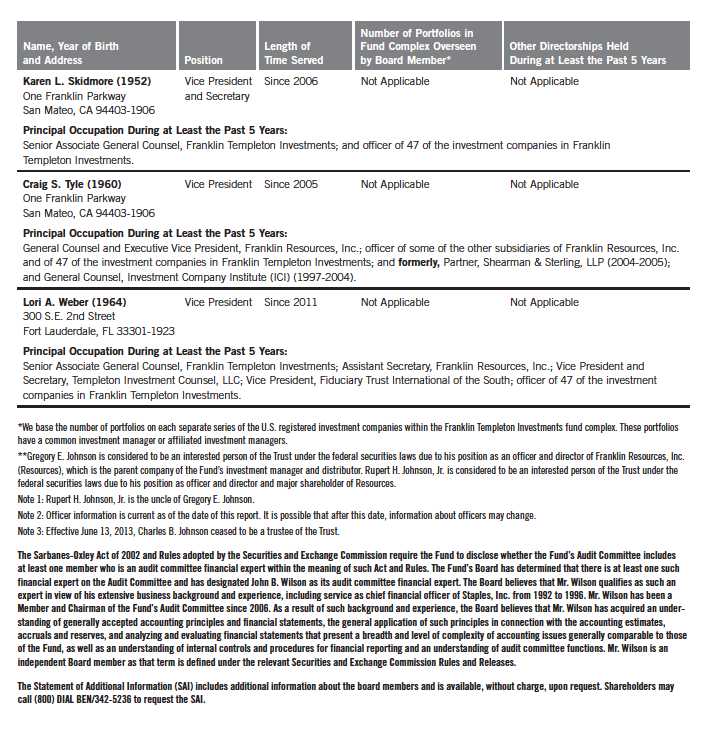
44 | Annual Report
Franklin Templeton Fund Allocator Series
Shareholder Information
Franklin Templeton Multi-Asset Real Return Fund
Board Review of Investment Management Agreement
At a meeting held February 26, 2013, the Board of Trustees (Board), including a majority of non-interested or independent Trustees, approved renewal of the investment management agreement for each of the separate funds within Franklin Templeton Fund Allocator Series, including Franklin Templeton Multi-Asset Real Return Fund (Fund(s)). In reaching its decision to approve renewal of the investment management agreements, the Board took into account information furnished throughout the year at regular Board meetings, as well as information prepared specifically in connection with the annual renewal review process. Information furnished and discussed throughout the year included investment performance reports and related financial information for each Fund, along with periodic reports on expenses, shareholder services, legal and compliance matters, pricing, brokerage commissions and execution and other services provided by the Investment Manager (Manager) and its affiliates, as well as a third-party survey of transfer agent fees charged funds within the Franklin Templeton Investments complex in comparison with those charged other fund complexes deemed comparable. Information furnished specifically in connection with the renewal process included a report for each Fund prepared by Lipper, Inc. (Lipper), an independent organization, as well as additional material, including a Fund profitability analysis prepared by management. The Lipper reports compared each Fund’s investment performance and expenses with those of other mutual funds deemed comparable to the Fund as selected by Lipper. The Fund profitability analysis discussed the profitability to Franklin Templeton Investments from its overall U.S. fund operations, as well as on an individual fund-by-fund basis. Additional material accompanying such profitability analysis included information on a fund-by-fund basis listing portfolio managers and other accounts they manage, as well as information on management fees charged by the Manager and its affiliates to U.S. mutual funds and other accounts, including management’s explanation of differences where relevant. Such material also included a memorandum prepared by management describing project initiatives and capital investments relating to the services provided to the Funds by the Franklin Templeton Investments organization, as well as a memorandum relating to economies of scale and an analysis concerning transfer agent fees charged by an affiliate of the Manager.
In considering such materials, the independent Trustees received assistance and advice from and met separately with independent counsel. While the investment management agreements for all Funds were considered at the same Board meeting, the Board dealt with each Fund separately. In approving continuance of the investment management agreement for each Fund, the Board, including a majority of independent Trustees, determined that the existing management fee structure was fair and reasonable and that continuance of the investment management agreement was in the best interests of each Fund and its shareholders. While attention was given to all information furnished, the following discusses some primary factors relevant to the Board’s decision.
Annual Report | 45
Franklin Templeton Fund Allocator Series
Shareholder Information (continued)
Franklin Templeton Multi-Asset Real Return Fund
Board Review of Investment Management Agreement (continued)
NATURE, EXTENT AND QUALITY OF SERVICE. The Board was satisfied with the nature and quality of the overall services provided by the Manager and its affiliates to the Fund and its shareholders. In addition to investment performance and expenses discussed later, the Board’s opinion was based, in part, upon periodic reports furnished it showing that the investment policies and restrictions for the Fund were consistently complied with as well as other reports periodically furnished the Board covering matters such as the compliance of portfolio managers and other management personnel with the code of ethics adopted throughout the Franklin Templeton fund complex, the adherence to fair value pricing procedures established by the Board, and the accuracy of net asset value calculations. The Board also noted the extent of benefits provided Fund shareholders from being part of the Franklin Templeton family of funds, including the right to exchange investments between the same class of funds without a sales charge, the ability to reinvest Fund dividends into other funds and the right to combine holdings in other funds to obtain a reduced sales charge. Favorable consideration was given to management’s continuous efforts and expenditures in establishing back-up systems and recovery procedures to function in the event of a natural disaster, it being noted that such systems and procedures had functioned well during the Florida hurricanes and blackouts experienced in previous years, and that those operations in the New York/New Jersey area ran smoothly during the more recent Hurricane Sandy. Among other factors taken into account by the Board were the Manager’s best execution trading policies, including a favorable report by an independent portfolio trading analytical firm, which also covered FOREX transactions. Consideration was also given to the experience of the Fund’s portfolio management team, the number of accounts managed and general method of compensation. In this latter respect, the Board noted that a primary factor in management’s determination of a portfolio manager’s bonus compensation was the relative investment performance of the funds he or she managed and that a portion of such bonus was required to be invested in a predesignated list of funds within such person’s fund management area so as to be aligned with the interests of shareholders. The Board also took into account the quality of transfer agent and shareholder services provided Fund shareholders by an affiliate of the Manager and the continuous enhancements to the Franklin Templeton website. Particular attention was given to management’s conservative approach and diligent risk management procedures, including continuous monitoring of counterparty credit risk and attention given to derivatives and other complex instruments including expanded collateralization requirements. The Board also took into account, among other things, management’s efforts in establishing a global credit facility for the benefit of the Fund and other accounts managed by Franklin Templeton Investments to provide a source of cash for temporary and emergency purposes or to meet unusual redemption requests as well as the strong financial position of the Manager’s parent company and its commitment to the mutual fund business as evidenced by its subsidization of money market funds.
46 | Annual Report
Franklin Templeton Fund Allocator Series
Shareholder Information (continued)
Franklin Templeton Multi-Asset Real Return Fund
Board Review of Investment Management Agreement (continued)
INVESTMENT PERFORMANCE. The Board placed significant emphasis on the investment performance of the Fund in view of its importance to shareholders. While consideration was given to performance reports and discussions with portfolio managers at Board meetings throughout the year, particular attention in assessing performance was given to the Lipper reports furnished for the agreement renewal. The Lipper reports prepared for the Fund showed the investment performance of its Class A shares in comparison to a performance universe selected by Lipper. Comparative performance for the Fund was shown for the one-year period ended December 31, 2012. The performance universe for the Fund consisted of the Fund and all retail and institutional global flexible portfolio funds. The Fund has been in existence for only one full year and the Lipper report showed its 2012 total return to be in the lowest performing quintile of such universe. The Board did not consider such performance to be particularly meaningful in view of the Fund’s short period of operations. The Board also noted management’s observation that the performance universe was broad and included funds with a much higher equity exposure than that of the Fund whose objective is to seek total return that exceeds U.S. inflation.
COMPARATIVE EXPENSES. Consideration was given to the management fee and total expense ratio of the Fund compared with those of a group of retail front-end load fund of funds selected by Lipper as its appropriate Lipper expense group. Lipper expense data is based upon information taken from each such fund’s most recent annual report, which reflects historical asset levels that may be quite different from those currently existing, particularly in a period of market volatility. While recognizing such inherent limitation and the fact that expense ratios generally increase as assets decline and decrease as assets grow, the Board believed the independent analysis conducted by Lipper to be an appropriate measure of comparative expenses. In reviewing comparative costs, Lipper provides information on the Fund’s contractual investment management fee in comparison with the contractual investment management fee that would have been charged by other funds within its Lipper expense group assuming they were similar in size to the Fund, as well as the actual total expense ratio of the Fund including expenses of the underlying funds it invests in. The Board noted that the Fund pays an asset allocation advisory fee. The Lipper contractual investment management fee analysis includes the administrative fee and asset allocation advisory fee directly charged to the Fund as being part of the contractual investment management fee, with the investment management fees charged underlying funds being included within actual total expenses. Contractual investment management fees and total expenses, for comparative consistency, are shown by Lipper for Fund Class A shares. The Lipper report for the Fund showed its contractual management fee rate was less than five basis points higher than its expense group median, but its actual total expense ratio was below the median of such expense group. The Board found the comparative expenses of the Fund as shown in the Lipper report to be acceptable, noting that such expenses were being subsidized by fee waivers.
Annual Report | 47
Franklin Templeton Fund Allocator Series
Shareholder Information (continued)
Franklin Templeton Multi-Asset Real Return Fund
Board Review of Investment Management Agreement (continued)
MANAGEMENT PROFITABILITY. The Board also considered the level of profits realized by the Manager and its affiliates in connection with the operation of the Fund. In this respect, the Board reviewed the Fund profitability analysis that addresses the overall profitability of Franklin Templeton’s U.S. fund business, as well as its profits in providing management and other services to each of the individual funds during the 12-month period ended September 30, 2012, being the most recent fiscal year-end for Franklin Resources, Inc., the Manager’s parent. In reviewing the analysis, attention was given to the methodology followed in allocating costs to the Fund, it being recognized that allocation methodologies are inherently subjective and various allocation methodologies may each be reasonable while producing different results. In this respect, the Board noted that, while being continuously refined and reflecting changes in the Manager’s own cost accounting, the allocation methodology was consistent with that followed in profitability report presentations for the Fund made in prior years and that the Fund’s independent registered public accounting firm had been engaged by the Manager to periodically review the reasonableness of the allocation methodologies solely for use by the Fund’s Board in reference to the profitability analysis. In reviewing and discussing such analysis, management discussed with the Board its belief that costs incurred in establishing the infrastructure necessary for the type of mutual fund operations conducted by the Manager and its affiliates may not be fully reflected in the expenses allocated to the Fund in determining its profitability, as well as the fact that the level of profits, to a certain extent, reflected operational cost savings and efficiencies initiated by management. The Board also took into account management’s expenditures in improving shareholder services provided the Fund, as well as the need to implement systems and meet additional regulatory and compliance requirements resulting from statutes such as the Sarbanes-Oxley and Dodd-Frank Acts and recent SEC and other regulatory requirements. In addition, the Board considered a third-party study comparing the profitability of the Manager’s parent on an overall basis to other publicly held managers broken down to show profitability from management operations exclusive of distribution expenses, as well as profitability including distribution expenses. The Board also considered the extent to which the Manager and its affiliates might derive ancillary benefits from fund operations, including revenues generated from transfer agent services and potential benefits resulting from allocation of fund brokerage and the use of commission dollars to pay for research. Based upon its consideration of all these factors, and taking into account the fact that Fund expenses were being subsidized through fee waivers, the Board determined that the level of profits realized by the Manager and its affiliates from providing services to the Fund was not excessive in view of the nature, quality and extent of services provided.
ECONOMIES OF SCALE. The Board also considered whether economies of scale are realized by the Managers as the Fund grows larger and the extent to which this is reflected in the level of management fees charged. While recognizing that any precise determination is inherently subjective, the Board noted that based upon the Fund profitability analysis, it appears that as some funds get larger, at some point economies of scale do result in the Managers realizing a larger profit margin
48 | Annual Report
Franklin Templeton Fund Allocator Series
Shareholder Information (continued)
Franklin Templeton Multi-Asset Real Return Fund
Board Review of Investment Management Agreement (continued)
on management services provided such a fund. The Board also noted that economies of scale are shared with a fund and its shareholders through management fee breakpoints so that as a fund grows in size, its effective management fee rate declines. The management fees charged by all or substantially all the underlying funds in which the Fund invests provide for such management fee breakpoints. Consequently, to the extent economies of scale may be realized by the investment managers of these funds, the benefits are shared with the Fund and its shareholders through a reduction in actual total expense ratios.
Proxy Voting Policies and Procedures
The Trust’s investment manager has established Proxy Voting Policies and Procedures (Policies) that the Trust uses to determine how to vote proxies relating to portfolio securities. Shareholders may view the Trust’s complete Policies online at franklintempleton.com. Alternatively, shareholders may request copies of the Policies free of charge by calling the Proxy Group collect at (954) 527-7678 or by sending a written request to: Franklin Templeton Companies, LLC, 300 S.E. 2nd Street, Fort Lauderdale, FL 33301, Attention: Proxy Group. Copies of the Trust’s proxy voting records are also made available online at franklintempleton.com and posted on the U.S. Securities and Exchange Commission’s website at sec.gov and reflect the most recent 12-month period ended December 31.
Quarterly Statement of Investments
The Trust files a complete statement of investments with the U.S. Securities and Exchange Commission for the first and third quarters for each fiscal year on Form N-Q. Shareholders may view the filed Form N-Q by visiting the Commission’s website at sec.gov. The filed form may also be viewed and copied at the Commission’s Public Reference Room in Washington, DC. Information regarding the operations of the Public Reference Room may be obtained by calling (800) SEC-0330.
Householding of Reports and Prospectuses
You will receive the Fund’s financial reports every six months as well as an annual updated summary prospectus (prospectus available upon request). To reduce Fund expenses, we try to identify related shareholders in a household and send only one copy of the financial reports and summary prospectus. This process, called “householding,” will continue indefinitely unless you instruct us otherwise. If you prefer not to have these documents householded, please call us at (800) 632-2301. At any time you may view current prospectuses/summary prospectuses and financial reports on our website. If you choose, you may receive these documents through electronic delivery.
Annual Report | 49
This page intentionally left blank.
This page intentionally left blank.
This page intentionally left blank.

Item 2. Code of Ethics.
(a) The Registrant has adopted a code of ethics that applies to its principal executive officers and principal financial and accounting officer.
(c) N/A
(d) N/A
(f) Pursuant to Item 12(a)(1), the Registrant is attaching as an exhibit a copy of its code of ethics that applies to its principal executive officers and principal financial and accounting officer.
Item 3. Audit Committee Financial Expert.
(a)(1) The Registrant has an audit committee financial expert serving on its audit committee.
(2) The audit committee financial expert is John B. Wilson, and he is "independent" as defined under the relevant Securities and Exchange Commission Rules and Releases.
Item 4. Principal Accountant Fees and Services.
(a) Audit Fees
The aggregate fees paid to the principal accountant for professional services rendered by the principal accountant for the audit of the registrant’s annual financial statements or for services that are normally provided by the principal accountant in connection with statutory and regulatory filings or engagements were $19,608 for the fiscal year ended May 31, 2013 and $29,609 for the fiscal year ended May 31, 2012.
(b) Audit-Related Fees
There were no fees paid to the principal accountant for assurance and related services rendered by the principal accountant to the registrant that are reasonably related to the performance of the audit of the registrant's financial statements and are not reported under paragraph (a) of Item 4.
There were no fees paid to the principal accountant for assurance and related services rendered by the principal accountant to the registrant's investment adviser and any entity controlling, controlled by or under common control with the investment adviser that provides ongoing services to the registrant that are reasonably related to the performance of the audit of their financial statements.
(c) Tax Fees
There were no fees paid to the principal accountant for professional services rendered by the principal accountant to the registrant for tax compliance, tax advice and tax planning.
The aggregate fees paid to the principal accountant for professional services rendered by the principal accountant to the registrant’s investment adviser and any entity controlling, controlled by or under common control with the investment adviser that provides ongoing services to the registrant for tax compliance, tax advice and tax planning were $4,600 for the fiscal year ended May 31, 2013 and $0 for the fiscal year ended May 31, 2012. The services for which these fees were paid include technical tax consultation for capital gain tax reporting to foreign governments.
d) All Other Fees
The aggregate fees paid to the principal accountant for products and services rendered by the principal accountant to the registrant not reported in paragraphs (a)-(c) of Item 4 were $0 for the fiscal year ended May 31, 2013 and $2 for the fiscal year ended May 31, 2012. The services for which these fees were paid include review of materials provided to the fund Board in connection with the investment management contract renewal process.
The aggregate fees paid to the principal accountant for products and services rendered by the principal accountant to the registrant’s investment adviser and any entity controlling, controlled by or under common control with the investment adviser that provides ongoing services to the registrant other than services reported in paragraphs (a)-(c) of Item 4 were $49,358 for the fiscal year ended May 31, 2013 and $170,656 for the fiscal year ended May 31, 2012. The services for which these fees were paid include preparation and review of materials provided to the fund Board in connection with the investment management contract renewal process. Other services include compliance examination for Investment Advisor Act rule 204-2 and 206-4(2).
(e) (1) The registrant’s audit committee is directly responsible for approving the services to be provided by the auditors, including:
(i) pre-approval of all audit and audit related services;
(ii) pre-approval of all non-audit related services to be provided to the Fund by the auditors;
(iii) pre-approval of all non-audit related services to be provided to the registrant by the auditors to the registrant’s investment adviser or to any entity that controls, is controlled by or is under common control with the registrant’s investment adviser and that provides ongoing services to the registrant where the non-audit services relate directly to the operations or financial reporting of the registrant; and
(iv) establishment by the audit committee, if deemed necessary or appropriate, as an alternative to committee pre-approval of services to be provided by the auditors, as required by paragraphs (ii) and (iii) above, of policies and procedures to permit such services to be pre-approved by other means, such as through establishment of guidelines or by action of a designated member or members of the committee; provided the policies and procedures are detailed as to the particular service and the committee is informed of each service and such policies and procedures do not include delegation of audit committee responsibilities, as contemplated under the Securities
Exchange Act of 1934, to management; subject, in the case of (ii) through (iv), to any waivers, exceptions or exemptions that may be available under applicable law or rules.
(e) (2) None of the services provided to the registrant described in paragraphs (b)-(d) of Item 4 were approved by the audit committee pursuant to paragraph (c)(7)(i)(C) of Rule 2-01 of regulation S-X.
(f) No disclosures are required by this Item 4(f).
(g) The aggregate non-audit fees paid to the principal accountant for services rendered by the principal accountant to the registrant and the registrant’s investment adviser and any entity controlling, controlled by or under common control with the investment adviser that provides ongoing services to the registrant were $53,958 for the fiscal year ended May 31, 2013 and $170,658 for the fiscal year ended May 31, 2012.
(h) The registrant’s audit committee of the board has considered whether the provision of non-audit services that were rendered to the registrant’s investment adviser (not including any sub-adviser whose role is primarily portfolio management and is subcontracted with or overseen by another investment adviser), and any entity controlling, controlled by, or under common control with the investment adviser that provides ongoing services to the registrant that were not pre-approved pursuant to paragraph (c)(7)(ii) of Rule 2-01 of Regulation S-X is compatible with maintaining the principal accountant’s independence.
Item 5. Audit Committee of Listed Registrants. N/A
Item 6. Schedule of Investments. N/A
Item 7. Disclosure of Proxy Voting Policies and Procedures for Closed-End Management Investment Companies. N/A
Item 8. Portfolio Managers of Closed-End Management Investment Companies. N/A
Item 9. Purchases of Equity Securities by Closed-End Management Investment Company and Affiliated Purchasers. N/A
Item 10. Submission of Matters to a Vote of Security Holders.
There have been no changes to the procedures by which shareholders may recommend nominees to the Registrant's Board of Trustees that would require disclosure herein.
Item 11. Controls and Procedures.
(a) Evaluation of Disclosure Controls and Procedures. The Registrant maintains disclosure controls and procedures that are designed to
ensure that information required to be disclosed in the Registrant’s filings under the Securities Exchange Act of 1934 and the Investment Company Act of 1940 is recorded, processed, summarized and reported within the periods specified in the rules and forms of the Securities and Exchange Commission. Such information is accumulated and communicated to the Registrant’s management, including its principal executive officer and principal financial officer, as appropriate, to allow timely decisions regarding required disclosure. The Registrant’s management, including the principal executive officer and the principal financial officer, recognizes that any set of controls and procedures, no matter how well designed and operated, can provide only reasonable assurance of achieving the desired control objectives.
Within 90 days prior to the filing date of this Shareholder Report on Form N-CSR, the Registrant had carried out an evaluation, under the supervision and with the participation of the Registrant’s management, including the Registrant’s principal executive officer and the Registrant’s principal financial officer, of the effectiveness of the design and operation of the Registrant’s disclosure controls and procedures. Based on such evaluation, the Registrant’s principal executive officer and principal financial officer concluded that the Registrant’s disclosure controls and procedures are effective.
(b) Changes in Internal Controls. There have been no changes in the Registrant’s internal controls or in other factors that could materially affect the internal controls over financial reporting subsequent to the date of their evaluation in connection with the preparation of this Shareholder Report on Form N-CSR.
Item 12. Exhibits.
(a)(1) Code of Ethics
(a)(2) Certifications pursuant to Section 302 of the Sarbanes-Oxley Act of 2002 of Laura F. Fergerson, Chief Executive Officer - Finance and Administration, and Gaston Gardey, Chief Financial Officer and Chief Accounting Officer
(b) Certifications pursuant to Section 906 of the Sarbanes-Oxley Act of 2002 of Laura F. Fergerson, Chief Executive Officer - Finance and Administration, and Gaston Gardey, Chief Financial Officer and Chief Accounting Officer
SIGNATURES
Pursuant to the requirements of the Securities Exchange Act of 1934 and the Investment Company Act of 1940, the registrant has duly caused this report to be signed on its behalf by the undersigned, thereunto duly authorized.
FRANKLIN TEMPLETON FUND ALLOCATOR SERIES
By /s/LAURA F. FERGERSON
Laura F. Fergerson
Chief Executive Officer - Finance and Administration
Date July 26, 2013
Pursuant to the requirements of the Securities Exchange Act of 1934 and
the Investment Company Act of 1940, this report has been signed below
by the following persons on behalf of the registrant and in the
capacities and on the dates indicated.
By /s/LAURA F. FERGERSON
Laura F. Fergerson
Chief Executive Officer - Finance and Administration
Date July 26, 2013
By /s/GASTON GARDEY
Gaston Gardey
Chief Financial Officer and Chief Accounting Officer
Date July 26, 2013